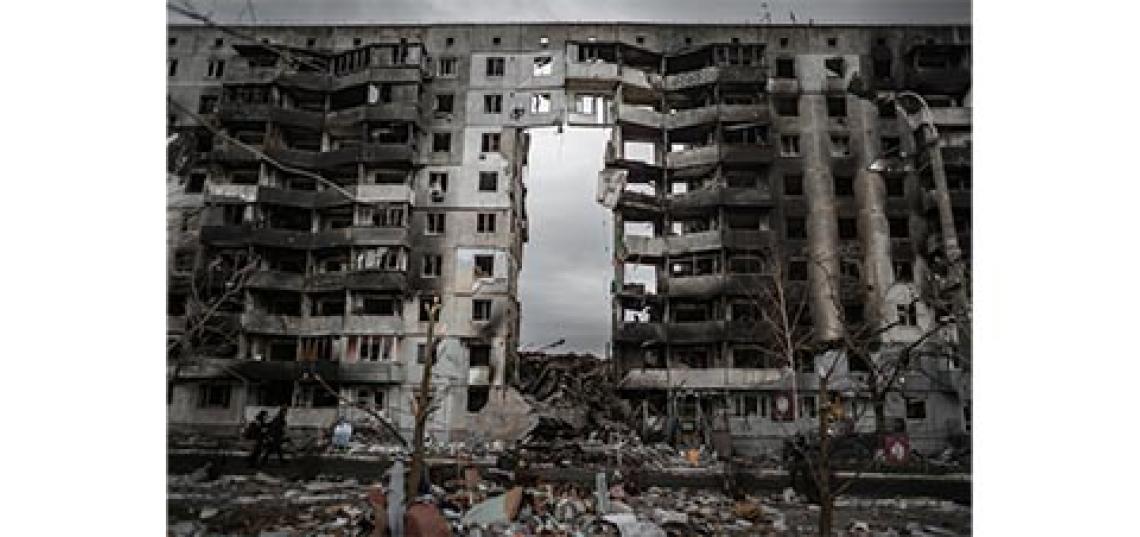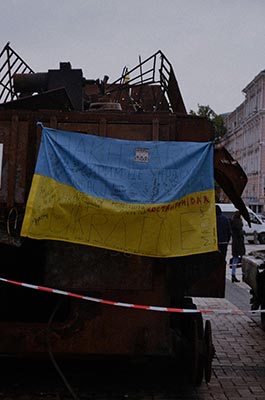
A Rutgers study identifies ten of the most important implications of the war in Ukraine for the news media. They are: the pursuit of truth; freedom of speech and press; independent journalism; fighting disinformation; understanding the patterns in how the news media have covered the war; public engagement; decisions surrounding which images of war to show the public; the role of media in a democratic society; the safety of journalists; and the impacts of immersive, and interactive and mobile media on the coverage of the war.
The study, “The Russian War in Ukraine and the Implications for the News Media” by SC&I Professor of Journalism and Media Studies John V. Pavlik, was published in the Athens Journal of Mass Media and Communications.
Among the study’s key findings, Pavlik said, is the role of news media in identifying misinformation and disinformation. “Propaganda about the war is increasingly digital in form and hard to spot. It can be very impactful on public opinion when audiences may be misled by falsehoods. The news media play a key role in serving as an independent entity that can vet mis- and disinformation, regardless of its source, Russian, Chinese, or American. State media are unable to reliably report the truth about the war. State media are themselves instruments of government propaganda. Russia has even criminalized critical reporting about the war.”
Among the study’s key findings, Pavlik said, is the role of news media in identifying misinformation and disinformation. “Propaganda about the war is increasingly digital in form and hard to spot. It can be very impactful on public opinion when audiences may be misled by falsehoods."
Pavlik conducted the study as a qualitative analysis of multiple news media including those operating in Ukraine, Russia (though most independent news media in Russia have been forced to close), and elsewhere.
Explaining the ways “truth has become a casualty in the Ukraine war,” Pavlik wrote that one of the ways this has happened “is through patterns of bias in news media coverage, particularly racial and cultural . . . a broad cross-section of news media, including media from the U.S., Europe and the Middle East, have described the victims of Putin’s Ukraine invasion in very different terms than the victims of conflicts in other parts of the world.”
Referencing the work of SC&I Assistant Teaching Professor of Journalism and Media Studies David Love, Pavlik wrote that Love reported on an incident when, describing the Ukraine refugees, “Al-Jazeera anchor Peter Dobbie, while speaking on the Qatari news network, said, ‘What’s compelling is looking at them, the way they are dressed. These are prosperous, middle-class people... These are not obviously refugees trying to get away from the Middle East...or North Africa. They look like any European family that you’d live next door to.’”
Pavlik said, “Reporting without bias, or being what journalists call objective, is central to providing news coverage of the war that is credible to the public. Research shows that perceived bias in the news is a primary factor in the erosion of public trust in journalism (Pew Research Center, 2022). Like truth, objectivity may be an unobtainable goal for any human journalist. But it is essential that journalists covering the war in Ukraine strive for being free of bias in their reporting or the public will lose confidence in the news and no longer believe the stories they see, hear or otherwise experience.”
Referring to two of the ten implications he identified in the paper, freedom of speech and press and independent journalism, Pavlik said, “the role of journalism in democratic versus authoritarian states is dramatically different. In a democracy, independent journalism acts as the Fourth Estate, essentially a check on government. This is a vital role during war when lives are at stake. But in an authoritarian or totalitarian state such as Russia, the role of the media is far from a Fourth Estate or government watch dog. During the war in Ukraine, the Russian media have been reduced to the role of government lapdog and act as a propaganda mechanism for the Putin regime. The result is increasingly a society living in an alternate, untruthful reality. Moreover, Russia has weaponized its state media propaganda. In April 2022 Russian television’s Rossiya-1 news channel threatened Britain with nuclear annihilation by airing a simulation of nuclear strikes by air and by sea destroying Britain and Ireland.”
Noting the significant interest media audiences have shown and continue to show in coverage of the war, Pavlik said this increase in public engagement has partly been driven by social media. “Social media,” Pavlik wrote, “has played a key role in transforming how people know about the war. Social media are a double-edged sword because social media platforms also can be used as an effective vehicle for propaganda. For news media, decisions about what images, photographic or videographic, have become an intense and urgent matter.”
Explaining the ever-growing impact of immersive, and interactive and mobile media on the coverage of the war which is currently continuing in the summer of 2024, Pavlik said, “The public can increasingly engage in news and information about the war using immersive digital means. For example, Ukraine director Oleg Sentsov has produced an 'immersive' documentary, 'Real,' shot in front-line trenches.”
However, Pavlik added, “Reporting about war, including in the war in Ukraine, is challenging, and often places journalists at risk of arrest, injury or even death. The Committee to Protect Journalists reports that ‘At least 15 journalists and media workers have been killed covering the war and CPJ is investigating whether the deaths of two others were related to their journalism.’ As a result, it is difficult for journalists to utilize the full range of storytelling tools in the journalist’s digital tool kit. Yet, many journalists and news media have found ways to use these tools effectively. Among the notable examples is Bellingcat, which has reported on the war using open-source evidence to verify the facts and establish truthful news about the conflict.”
Looking ahead at how American coverage of the war in Ukraine might change because of the upcoming U.S. presidential election, Pavlik said, “I think coverage of the war will continue to evolve. Depending on the outcome of the election, the U.S. news media perspective on the war, especially the role of the U.S. and NATO in the conflict, may shift.”
Describing how the faculty in the JMS Department trains students for careers as war correspondents, Pavlik said, “War correspondents are vital in producing truthful journalism reported from and about the world’s conflict zones. SC&I/JMS teaches its students about the essential role that original, independent reporting plays in conflict journalism and the critical role that verifying the facts plays in establishing the truth about those conflicts.”
“War correspondents are vital in producing truthful journalism reported from and about the world’s conflict zones. SC&I/JMS teaches its students about the essential role that original, independent reporting plays in conflict journalism and the critical role that verifying the facts plays in establishing the truth about those conflicts,” Pavlik said.
Pavlik added that following the news coverage of the war in Ukraine can provide important lessons for Journalism and Media Studies students. Among the most important of these lessons, Pavlik said, “is how important it is to maintain a critical or skeptical view. It is essential to consider the source of the news, especially during war, when propaganda is often disguised as the truth.”
Offering advice to JMS majors who are interested in becoming war correspondents, Pavlik said, “I would encourage them to follow the news closely and from multiple sources, comparing the news as reported. I also would encourage the reading of classic books on the role of the war correspondent, including Phillip Knightley's “The First Casualty.” Although his book is a novel, Seymour Topping’s “Fatal Crossroads: A Novel of Vietnam 1945” is also worth reading. Topping was a renowned foreign correspondent and an editor of The New York Times.
Learn more about the Journalism and Media Studies major on the School of Communication and Information website.
Photo credits: top: by Алесь Усцінаў for Pexels: https://www.pexels.com/photo/exploded-house-in-borodyanka-11734710/. Bottom: by lina hrm Lina for Pexels: https://www.pexels.com/photo/ukrainian-flag-on-a-rusty-machine-14570892/
